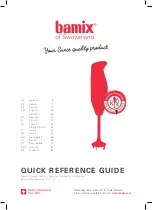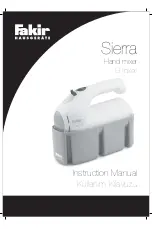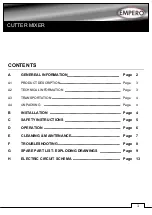
14
•
To melt chocolate for a recipe, put chopped chocolate in a double boiler insert or larger
bowl over a pan of barely simmering water. The water should not boil, nor should it touch
the bottom of the double boiler insert or bowl. If it does, this could cause the chocolate
to “seize” and you will not be able to use it in your recipe. Alternatively melt on medium
heat in a microwave oven.
•
Always test yeast for freshness before using it in a recipe. Sprinkle a little over warm
(40°C-43°C) water and add a pinch of sugar or flour from the recipe. If it does not
become foamy/bubbly in 5 to 10 minutes, the yeast may be “dead.” Start over with
fresh yeast from a new package.
BISCUIT BAKING
•
Use an ice cream scoop to measure out biscuit dough – this keeps the biscuits evenly
shaped and uniform in size. Ice cream scoops are also good for filling muffin tins.
•
To better maintain biscuit shapes, put scoops of biscuit dough onto sheets of kitchen
baking on a tray and chill before baking. This will keep the biscuit dough from spreading
too much and will maintain a nice round biscuit. If rolling and cutting biscuit dough,
always chill cut biscuit dough prior to baking to be sure the biscuits keep their shape.
Most biscuit dough can be refrigerated for 2 to 3 days prior to baking – be sure to wrap
well.
•
Biscuit dough may also be frozen. Shape into individual biscuits, double wrap and
freeze for up to 3 months. Thaw before baking.
•
Line baking sheets with kitchen baking paper for easy release and easy cleanup.
•
Let biscuits rest on sheets for 2 to 3 minutes before removing them to a wire rack to
cool. This keeps biscuits from wrinkling, crumbling or breaking.
•
Biscuits must cool completely before being put into storage containers to ensure they
don’t get soggy or misshapen.
BREAD BAKING
•
Using milk in place of water will produce a softer crust.
•
After baking, you can soften the crust, if desired, by rubbing it lightly with unsalted
butter soon after removing it from the oven. This prevents crust from drying out quickly.
•
If a recipe calls for a specific type of flour, use the flour recommended. If you do not
have bread flour, you can substitute plain flour, but your bread may not rise quite as
much.
•
Do not use tub margarines for bread baking – they have different structures and do not
work as well in baking.
•
For 100% whole-wheat bread, use 1½ teaspoons vital wheat gluten per cup of flour.
•
Many bread recipes have a “range” amount of flour – start by using the lower end of
the range, then add more flour as needed to produce a smooth, not sticky, dough.
•
Using too much liquid, or baking on a humid day, can cause your bread to fall or
wrinkle on top.
•
An instant-read thermometer is helpful to have on hand when making bread. It can
be used to measure the temperature of the liquid for proofing yeast and for taking the
internal temperature of the baked bread.
•
Liquid for proofing yeast should be between 40°C and 43°C.
•
Finished bread should have an internal temperature between 87°C and 98°C.











































